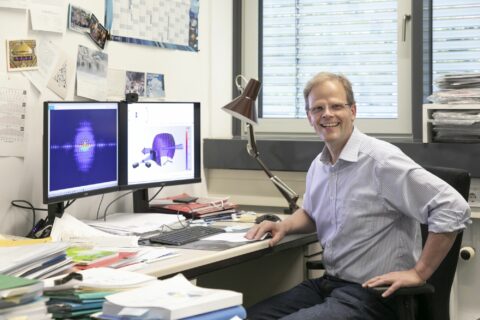“It opened a completely new door in quantum physics”
FAU researcher Joachim von Zanthier received his doctoral degree from the current Nobel Laureate in Physics Alain Aspect and was always impressed by Aspect's analysis and precision.
It doesn’t happen every day that your own doctoral supervisor receives the Nobel Prize. No wonder, then, that FAU quantum physicist Prof. Dr. Joachim Zanthier was a little taken aback when he learned that the Nobel Prize in Physics will be awarded this year to Alain Aspect, from whom Zanthier received his doctoral degree in the 1990s. In our interview, he reflects on his time in Paris.
You received your doctoral degree from Alain Aspect, one of the three current Nobel Prize winners in physics. Did the nomination surprise you?
I can’t say that it came as a sudden surprise. Proposals had already been made some time ago and he is evidently a worthy candidate for receiving the Nobel Prize. I have great respect for him as well as for the other two award winners. No matter how much knowledge has been gained in the field of quantum research, whatever has been done, invented and developed in this field: The fundamental discovery of entanglement – the essential property that we use in quantum physics for the “second quantum revolution” or Quantum Mechanics 2.0 – these three people were behind its success. “This discovery opened a new completely door in quantum physics” A door that has made possible all that we are researching today. And that was 40 years ago!
What exactly does entanglement mean?
Entanglement is a state that is only possible in quantum mechanics: it describes the interconnection of two or more particles that share a quantum state – they are interwoven in a particularly intense way that cannot be described in classical physics. If one measures the properties of one of the two particles – for example speed and position or polarization and frequency – the other is automatically measured and determined at the same moment, even if the two particles are light years apart. The trick here is that the speed and position of the first particle can initially be completely indeterminate and assume many values. This insight is essential for all current research areas of quantum physics – for quantum communication, for quantum computing and for quantum sensing, which can be used in medical imaging, for example.
What impressed you the most while working on your doctoral degree under the supervision of Alain Aspect?
He supervised my doctoral research after he had already moved to the Université Paris Sud, after 1990. But I got to know him at the École Normale Supérieure in Paris, the ENS, – and the whole surroundings there are particularly impressive. The ENS is a kind of incubator of talent for nuclear physics and quantum mechanics. Four Nobel Prize winners come from this laboratory alone, from Alfred Kastler, prize winner from 1966, whose pupil Claude Cohen-Tannoudji, who received the Nobel Prize in 1997, to his pupil Serge Haroche, prize winner in 2012, and Alain Aspect. This is phenomenal – and in that respect perhaps not entirely surprising.
What did you learn from working with Aspect and how does his research influence your scientific work today?
What I have learned from him are his rigorous method of analysis and the precision of his research. I have followed this approach in my research. Interestingly, in our research at the Erlangen site, we are continuing the work he laid the foundations for when he discovered entanglement in 1982. Incidentally, I did not do my doctorate on this at all – because after 1990, Alain devoted his research to atomic optics, a completely different topic. But when I came to Erlangen, I more or less accidentally began a research project that turned out to be closely related to what Alain had done before and for which his achievements are now being recognized. His scientific achievements are also the basis for our Center for Applied Quantum Technologies, which will be launched shortly.
What make Alain Aspect special as a person and as a scientist?
Alain Aspect is from the south of France and very spirited, very enthusiastic. He gives excellent, very vivid lectures. And he is considered sociable and very accessible. In a way, this also characterizes him as a scientist: he dives deep into analysis, takes the floor in discussions, asks questions, he is a bold researcher. His work in quantum physics, which he did at a very early age, also shows his determination. Measuring entanglement had been impossible until then – he had an idea of how it might be done and then he proved it. It was a colossal pioneering achievement.
Contact
Prof. Dr. Joachim von Zanthier
Professorship for Experimental Physics
